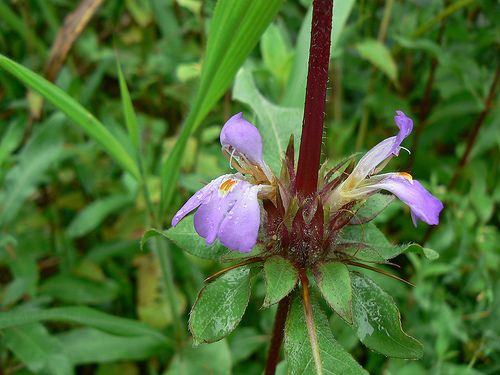BOTANICAL NAME: Asteracantha longifolia Nees.
FAMILY: Acanthaceae
CLASSICAL CLASSIFICATION:
Charaka: Shukrashodhana
Bhavaprakash: Guduchyadi varga
ENGLISH NAME: Hygrophila
COMMON NAME:
Hindi: Talimakhana, Kokilaskha

REFERENCE: BHAVAPRAKASH SAMHITA with link e Nighantu:
https://niimh.nic.in/ebooks/e-Nighantu/bhavaprakashanighantu/?mod=read
कोकिलाक्षस्तु काकेक्षुरिक्षुरः क्षुरकः क्षुरः ।
भिक्षुः काण्डेक्षुरप्युक्त इक्षुगन्धेक्षुबालिका ॥२२४॥
क्षुरकः शीतलो वृष्यः स्वाद्वम्लः पिच्छिलस्तथा ।
तिक्तो वातामशोथाश्मतृष्णादृष्ट्यनिलास्त्रजित् ॥२२५॥
HABITAT: found all over India near water source, fields and marshy land
BOTANICAL DESCRIPTION:
It is a small plant of 3 to 5 feet height with small thorns or hairy parts all over the plant, flowers are of purple color, seeds are black in color and swells and becomes slimy when comes in contact with water or saliva, fruits and flowers are seen in the month of September to November.
AYURVEDIC CHARACTERISTICS:
| RASA | GUNA | VEERYA | VIPAKA | PRABHAVA | DOSHGHNTA |
| Madhura | Guru, Snigdha | Shita | Madhura | – | Vaatpittashamak |
AYURVEDIC ENERGETICS:
| TASTE | PROPERTY | POTENCY | POST DIGESTIVE EFFECT | EFFECT ACTION | DOSHA ACTION |
| Sweet | Heaviness,
Slimy |
Cold | Sweet | – | Vatapitta
Pacifying |
MAJOR CHEMICAL CONSTITUENTS: Lupeol, stigmasterol, sterols
THERAPEUTIC USES:
- Joint pain: Decoction prepared from the coarse powder of Kokilaksha is to be taken with suitable medicines like Kaishore guggul.
- Stones: Preparation of Kokilaksha (it’s kshara) is found to be effective in dissolving gall stones.
- General debility: Its powder is administered with luke warm milk
INDICATIONS:
Vatajroga Vatadisorders, Amvata Rheumatoid arthritis, Ashmari renal calculi, Trishna Excessive thirst, Shotha Inflammation, Raktavikara Bleeding disorders, Pandu Anaemia, Vatarakta Gout, Vibandha Constipation, Anaha Bloating
USEFUL PART: Root, Seeds
DOSAGE: 5-10ml (Kwath), 3 to 6 gm (Churna)
AYURVEDIC FORMULATION:
Panaviraladi Bhasma (Kshara)
